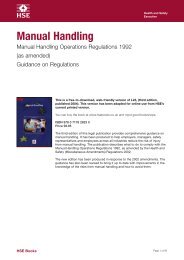Making Companies Safe - what works? (CCA ... - Unite the Union
Making Companies Safe - what works? (CCA ... - Unite the Union
Making Companies Safe - what works? (CCA ... - Unite the Union
You also want an ePaper? Increase the reach of your titles
YUMPU automatically turns print PDFs into web optimized ePapers that Google loves.
A recent HSE discussion paper illustrates <strong>the</strong> shift that appears to lie behind HSE’s new<br />
strategy:<br />
“In terms of <strong>the</strong> balance of our efforts we want to put more emphasis on <strong>the</strong><br />
‘educate and influence’ aspects of our work and working in partnership with<br />
o<strong>the</strong>rs (at all levels) who can help achieve <strong>the</strong> improvement in health and safety<br />
performance for which we strive. Encouraging our staff to use <strong>the</strong>ir authority and<br />
experience more on <strong>the</strong>se activities means using a smaller proportion of our total<br />
front line resource for <strong>the</strong> inspection and enforcement aspects of our work.” 4<br />
While some of <strong>the</strong> proposed strategies for achieving <strong>the</strong>se aims are new – such as <strong>the</strong> use of<br />
intermediaries to lever small and medium enterprises – <strong>the</strong> basic paradigm is not. HSE has<br />
always put some emphasis on providing information and guidance to employers outside of<br />
an enforcement context, and has for many years attempted to persuade employers of <strong>the</strong><br />
business benefits of improving <strong>the</strong>ir OHS performance. What is new, however, is <strong>the</strong> emphasis<br />
that <strong>the</strong> HSC is willing to give it.<br />
The second and third parts of this report are concerned with which of <strong>the</strong> various compliance<br />
strategies are <strong>the</strong> most effective. In particular <strong>the</strong>y will look at <strong>the</strong> relative effectiveness of<br />
strategies using formal enforcement – inspections, investigation, notices and prosecutions –<br />
compared with ‘voluntary’ approaches that are solely concerned with raising awareness,<br />
educating, and persuading employers that <strong>the</strong>y need to make changes to comply with<br />
<strong>the</strong> law.<br />
Part two looks at <strong>the</strong> effectiveness of ‘formal enforcement’ strategies and <strong>the</strong> implications<br />
<strong>the</strong>se strategies have for <strong>the</strong> HSE. What <strong>the</strong> research shows pretty unambiguously is that<br />
<strong>the</strong>se strategies are effective – and that <strong>the</strong>y could be even more effective if levels of<br />
inspections, investigations, imposition of notices and prosecutions were increased.<br />
Part three looks at <strong>the</strong> effectiveness of strategies seeking compliance without enforcement –<br />
for example, through use of campaigns, mailshots, and seminars.<br />
38
















